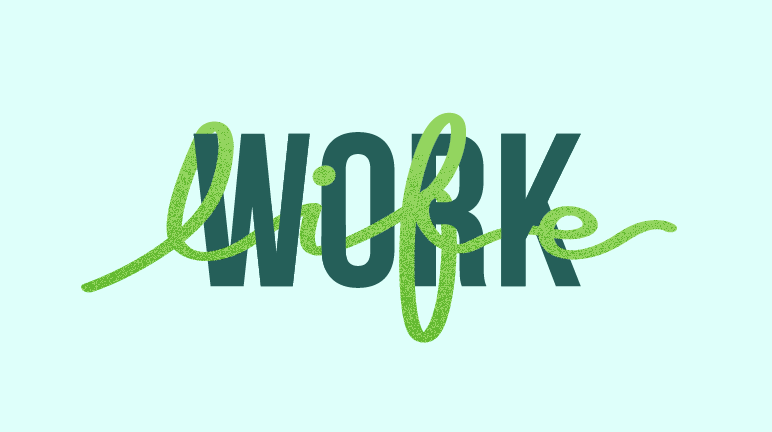productivity tips · Aug 10, 2021
Work-Life Balance is so Yesterday, Now We Need Work-Life Integration

Work-life balance and work-life integration. They sound like pretty much the same thing, right? Well, they sort of are. But with one important difference.
You see, language is about more than just semantics it’s about ideas and images associated with words and phrases.
Work-life balance conjures up a particular image, an idea that kind of made sense when you went into work every day. Whereas work-life integration is more about finding harmony between work and life.
The sameness of the two phrases is also why the ways you can implement work-life integration into your daily life will look (and read) a lot like tips on work-life balance. As well as tips on being productive while working from home.
In this post, we’re going to:
- break down the real differences between the two.
- explain why thinking about it as work-life integration produces a better result.
- show you how to achieve that better result with a few easy to implement tips and tricks.
The difference between work-life balance and work-life integration
The problem with the idea of work-life balance is it implies a trade-off. You must juggle work/school with home/family with community with yourself. And so, this implies that one of these four main aspects of our lives will, at some point, lose out or be sacrificed.
But this juggling act doesn’t really sound all that realistic. It also sounds like a lot of effort for not much gain—which hardly sounds gratifying.
Better to work towards integration.
Instead of juggling, try to integrate your work in with the other main areas of your life. Essentially, aiming to get wins in all main aspects of your life.
This is the key difference between the two. Not dealing in trade-offs but finding synergy.
Integration is what happens when experiences or attitudes in one aspect of your life positively spill into another aspect. Or when they help to enrich another of aspect of your life.
Read more on how to win as a remote team that promotes work-life integration.
Why work-life integration is better for you
Integration is better for you than work-life balance because it’s more seamless. And it eliminates the competitive mindset we sometimes get into about our personal and professional lives.
Instead of trying to completely compartmentalize and segment aspects of our lives, work-life integration is about providing people with the opportunity to become creative. To find new ways of making things better in all aspects of their lives.
When it’s not better for you
Let’s be honest. This is not some sort of magic cure-all.
For some professions, some personality types, and people with dependents, work-life balance is sometimes the most tenable, workable solution. There as those who try work-life integration and end up bogged down trying to do too much and become overloaded.
Then there is the fact, that for work-life integration to work well, it requires the employer to be on board. For work-life integration to be successful: you require a supportive family structure as well as a shift in workplace cultures.
6 steps to make work-life integration work for you
If this does sound appealing to you, having a plan in place is essential. After all, it’s not as though you can drop everything you are doing and just start into work-life integration. Although, it would be nice if you could pick up all your personal and professional obligations and throw into in blender and get it to the right consistency…
But no, a plan is needed. And here are 6 steps to help you on your way to integrating work with your personal life.
1. Your idea of work-life integration
First off, understand that this is not a one-size-fits-all approach. Your idea of work-life integration needs to be based off your personal life, your personality, your work schedule, and your overall goals.
One way of starting to think about this is to ask yourself: “what does an ideal week look like?”
This question will help you put into focus your work and family commitments as well as any personal time you’d like to have (if possible).
2. Map out your ideal week
Once you have an idea of what your ideal week looks like, the next step is to consider your familial and work obligations and the steps you need to meet those obligations.
Remember: for this to be successful you need support from family and work. So, part of your plan must involve not only what you will do, but also what (if any) support you will need and from where you will need that support.
3. Schedule
Now that you have your ideal week mapped out, along with the steps and support necessary to be successful. It’s time to turn that into a weekly schedule. This schedule should have when you plan to work out, relaxation, time with family, meal prep, and so on.
Having a schedule that integrates the personal and the professional can help you be more productive at work, and more present with your loved ones.
4. Boundaries
If you’re working: work. If you’re relaxing: relax. There are one or two important caveats to this, however. If you’re relaxing but something about work is nagging at you, briefly discuss it with someone—getting it off your chest can help you to relax. Which means you can enjoy yourself more, and when you return to work it want be gnawing at you. Or, at least, it won’t be gnawing at you as much.
When you make the schedule, it is very important you stick to it. The better you do that, the better a result you will see.
Now, obviously if you have to schedule a meeting that cuts into leisure time—then make sure you catch up on that leisure time later on. Don’t just think, “oh well, it didn’t happen today, that’s okay.”
No. In order for this work, it must become habit. You must get used to integrating the two so you enjoy your downtime as well as get the most out of your working hours.
5. Communication
As mentioned at the top of this post: this won’t work without the support of your workplace. In an ideal world, your workplace supports the concept and will help you make it happen.
However, because this is a personal choice—it is likely you will need to initiate the conversation with your employer. If you’re an employer or in a managerial position, you’re in a fantastic position to help your team out by recommending work-life integration to them.
If you do find yourself working for a company which doesn’t support this approach, you can kind of do it on your own. But it won’t be the same. However, you can block chunks off time out of your calendar to create personal boundaries.
6. Trial and error
The final step is accepting that you may not succeed right away. You may create a schedule and think you’ve successfully integrated work and life only to find out you’re still juggling and still trying to make too many compromises.
That’s why it’s necessary to approach your initial schedule as a learning process. Figure out what does work and what doesn’t. Discover—and learn from—the difference between what your ideal week looks like, and what you can realistically do in one week.
There’s no need to be a perfectionist—and in fact, it’s probably better if you leave the perfectionism for something other than this schedule.
As you go along make adjustments until you get your week to a place that integrates nicely between your job and personal life.
Now is the time for work-life integration
Even if you think work-life balance and work-life integration sound like the same thing. It’s a useful to use work-life integration phrase because it influences both your behavior and mindset. Part of this is getting away from the idea of seeing things as trade-offs.
Rather you should focus on creating a sense of harmony amongst the varying aspects of your life. If you can do that, and find a way to enjoy and thrive in all aspects of your life then you will find life becomes more rewarding.
The role of productivity in work-life integration
As mentioned, your workplace’s involvement can be crucial in the success of this integration. With productivity software, like project management software, you can better communicate with your colleagues, plan out your week in advance, and better stay on top of project deadlines.
At a time when most people are still working from home, project management software is a vital tool to ensure a cohesive work experience from home.
It can also make planning and mapping out work-life integration easier with calendar app integration and real-time communication and task commenting.
Let us know in the comment section what you think of a work-life integration lifestyle and how you expect to achieve.


